Bedbug infestations are nothing to take lightly. They are blood-sucking insects that seemingly come out of nowhere and infest homes and businesses by the thousands. Without effective bedbug control, these pests can take over residential interiors and bring a halt to businesses like hotels and motels.
What are Bedbugs?

Bedbugs on mattress - Actual size: 0.18 inches (4.5 mm)
Bedbugs are true bugs and belong to the order Hemiptera. True bugs like the bedbug have a stylet. Whereas some bugs use this straw-shaped mouth to suck juices from plants, bedbugs use their stylet to suck blood from people. Though bedbugs will feed on household pets or animals in the wild, they prefer humans as their primary food source.
Some people have misconceptions about bedbugs due to faulty information. Let's clear up some of those misconceptions before diving any further into Pedchem's Ultimate Guide to Bedbugs.
- Bedbugs are not lice and can't live or hide in your hair.
- Bedbugs are bugs; ticks are arachnids like spiders.
- Bedbugs can be found in places other than bedrooms.
- Bedbugs don't transmit diseases to people.
- Bedbugs don't bite; they puncture skin with their stylet.
- Bedbug punctures may cause allergic reactions in some people.
- Bedbugs are not too small to see.
- Bedbugs move slowly, not fast like roaches.
- Bedbugs cannot lay eggs under your skin.
What Do Bedbugs Look Like?
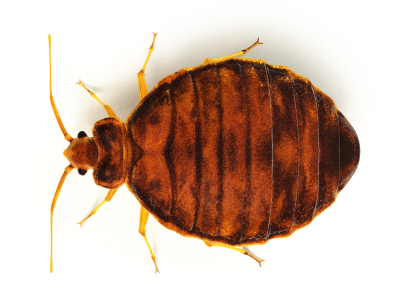
Top-down view of a bedbug - Image by bedbugs.org
Adult bedbugs have brown, oval-shaped bodies and appear flat until they've had a blood meal. Once they feed, they expand like a balloon and retreat to their hiding spot; they may also appear more reddish in color after consuming blood. They're small bugs with six legs and two antennae and only measure about 4 or 5 millimeters in length. Some adults may have a slightly darker patch on their backs. Unlike other bugs, bedbugs do not have wings. However, they do have wing pads that never fully develop as they mature. They crawl along surfaces very slowly and can be identified easily with the naked eye.
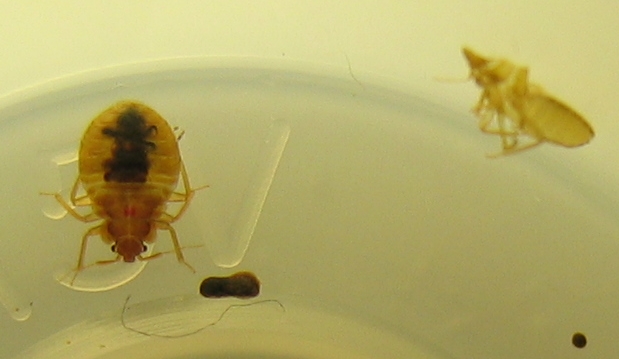
Bedbug nymph shedding its skin - Image by bedbugs.org
Bedbug nymphs, on the other hand, are difficult to see and can go unnoticed until they mature. When the nymphs hatch from the eggs, they measure about the size of a pin head and appear tan or white in color. Once they feed, their bodies turn red and grow to the size of an apple seed. Immature bedbugs also feed on people and will begin feeding almost immediately after emerging from the eggs.
What is the Problem With Bedbugs?
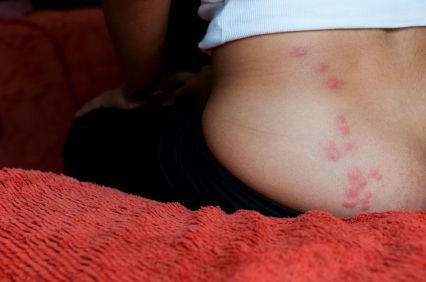
Bedbug bites on back - Image by bedbugs.org
One major problem with bedbugs is their food source: human blood. Another problem is their breeding cycle. A female bedbug lays between one and five eggs every day. She doesn't require a nest or any special place in which to lay her eggs. In fact, she can lay them on most any surface, from beds and carpets to furniture and electronics. One adult female can lay as many as 500 eggs in her lifetime, which can lead to a serious infestation in no time. If multiple bedbugs occupy the same space, it won't take long for the numbers to triple and quadruple, leading to a massive problem for residences and businesses.
Bedbugs also don't travel very far from where they hatched, so their population in one area can explode tenfold in a matter of weeks. Unfortunately, these pests are adept at hitchhiking and can hide in luggage, clothing and other belongings. There's also another problem. Adult bedbugs can live for close to five months without food; the nymphs can survive for several weeks. Because they can live for so long without a blood meal, it's easy for them to hitchhike and to find a food source no matter if it's in a transport vehicle or a populated business.
One more problem with bedbugs is their extreme resistance to various insecticides. It's this resistance that makes the bugs so hard to treat. In fact, most common bedbugs have a mutation that helps them to survive chemical substances that are used in many different pesticides to eliminate infestations. However, some newer insecticides have improved formulas for combating bedbugs and their eggs.
Where are Bedbugs Found?
Bedbugs are found in most every country in the world and have only recently surged in numbers in the past two decades. Their numbers declined between the 1930s and the 1980s but began to increase in the 90s. They exploded in the early 2000s with schools, businesses and homes becoming infested with these bloodthirsty insects. They can be found in most any interior building and thrive in temperate climates. Some of the most common places to find bedbugs include:
- Apartment buildings
- Hotels
- Buses and bus stops
- Offices
- Bed and Breakfasts
- Motels
- Taxicabs
Because females lay so many eggs each day, it only takes one bug to create an infestation in homes, businesses and transport vehicles. They're mostly nocturnal and prefer to feed on humans as they lie dormant in bed. However, some bedbugs may also feed during the day.
Where Do Bedbugs Come From?
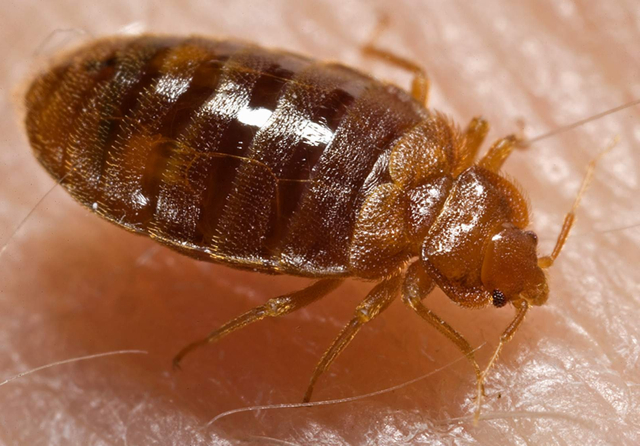
Bedbug on a person's skin - Image by bedbugs.org
Bedbugs invade homes and businesses on a regular basis, but where do they come from originally? A research paper was published in the journal of Molecular Ecology and suggests that bats were the original carriers of bedbugs. Fossilized bedbugs from 3,500 years ago show that these bugs have lived among humans for a long time. The researchers believe that the bat bedbug lineage dates back to a time when bats and humans lived in the same caves.
Today, bedbugs are a common pest in homes, businesses, institutions and other buildings. They multiply by the hundreds in just a few weeks and can live without food for months at a time. These pests survive the harshest chemical treatments and will hitchhike from place to place until they find the ideal location to call home. They hide in out-of-the-way places such as mattress seams and the gaps behind baseboards.
No matter if you're dealing with bedbugs or wanting to prevent an infestation, Pedchem has all the information available to help you learn more about bedbugs, as well as how to eliminate these blood-sucking pests from your home or business.
Inspection: How to Locate Bedbugs
It's best to find bedbugs before an infestation occurs; otherwise, you could be in for a serious problem. These bugs may not travel far from their hatching site, but they'll quickly spread to other parts of the interior after hitchhiking on clothing and other items. They might even hitch a ride to your friend's or family member's house and infest their living spaces. Treating a minor infestation will be much easier and require less money out of your pocket.
Unfortunately, minor infestations are not so simple to locate, and it's easy to mistake other insects for bedbugs, such as carpet beetles and ticks. Misidentification is one of the leading causes of prolonged and worsened bedbug infestations in homes. If you misidentify the bugs, they'll have more time to spread throughout the room and into other parts of your house. You may also attempt to treat the insects with the incorrect pesticides and waste both time and money.
Signs of Bedbugs
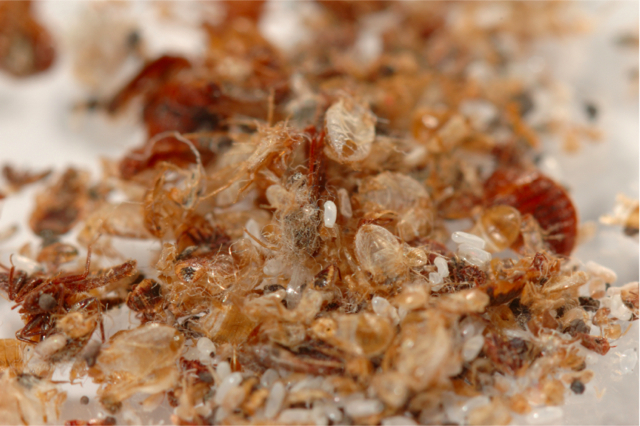
Bedbug feces, carcasses and skins - Image by bedbugs.org
The best way to identify a bedbug infestation is to look for signs of their presence. You might not see bedbugs out in the open during the day, but you may see visual clues that they're in your home if you know where to look. Because bedbugs harbor in furniture, bedding and tight crevices, you'll have to inspect the room thoroughly with a keen eye. Otherwise, you could miss the signs altogether and allow the infestation to continue.
Looking for live bugs isn't always the answer. Bedbugs leave behind signs in places where they're hiding, and the signs look the same no matter if they're in a hotel room or someone's home. Ignoring any of these signs can lead to more problems in the future, such as a larger infestation and the potential to spread the bugs to other homes and businesses. Some of the common bedbug signs include:
- Small, black dots in the infested area. These dots are the bugs' feces and measure about the size of a bullet point in this list.
- Reddish brown stains on the sheets or other places where the bugs have been crushed. You may find the stains beneath couch cushions, mattresses and rugs.
- Molted skin from bedbug nymphs. You might also see the eggs, but you'll need help from a magnifying glass since they measure about 1 millimeter in length.
- Live bedbugs on your skin. However, it's not common to find a bedbug feeding on you since it attacks while you're asleep.
- Itchy red bumps on your skin from bedbug bites. The bumps may appear like a rash and spread across the bite area.
Where Do Bedbugs Hide?
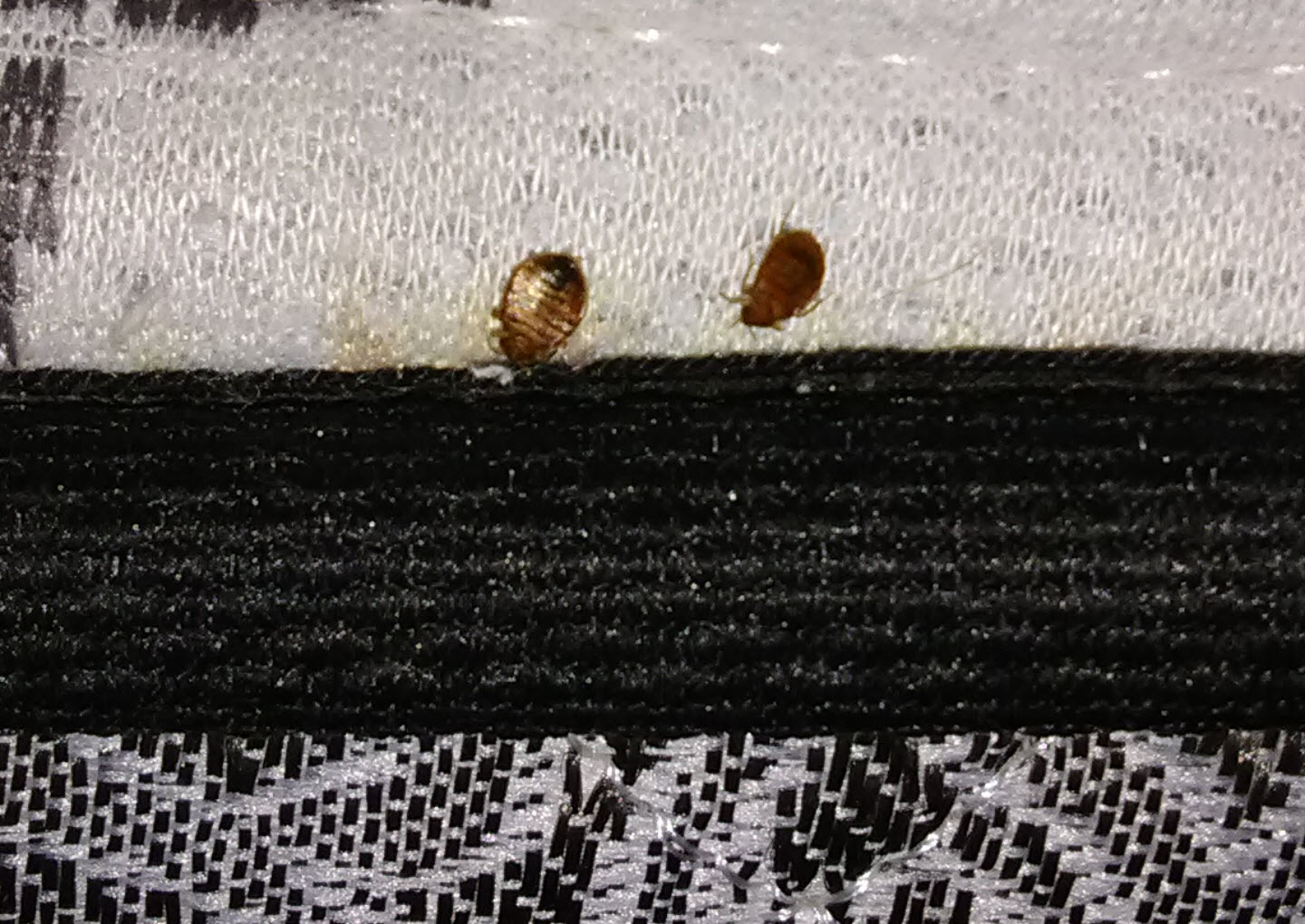
Bedbugs on fabrics - Image by bedbugs.org
Bedbugs don't really hide in homes and businesses. They're actually nesting in various places out of sight like any other insect or animal would. Because they're so small, they appear to be hiding and making it difficult for people to locate them easily. If you want to find the bugs, it pays to look in common harboring sites in your living spaces. When they're not feeding, bedbugs can be found almost anywhere in a room, such as in the seams of your mattress or the crevices in a couch.
Heavy infestations have to spread out to other parts of the interior. Otherwise, the insects will quickly overpopulate their nesting site and make it easier for people to spot them. Even if you're unsure about the severity of the infestation, it's best to look for bedbugs in areas that you might not think about, such as in drawer joints and behind wall hangings. Some other common nesting sites include the areas in and around:
- Curtain folds
- Loose wallpaper
- Electrical outlets
- Appliances
- Bookshelves
Bedbugs have flat bodies, so it's easy for them to squeeze into the tightest cracks and crevices. Make sure to check between books and decor on shelves and along the edges of window and door frames. Check under loose tiles and in the cracks along wood flooring, including the heads of screws and other inconspicuous places.
How to Perform Visual Inspections
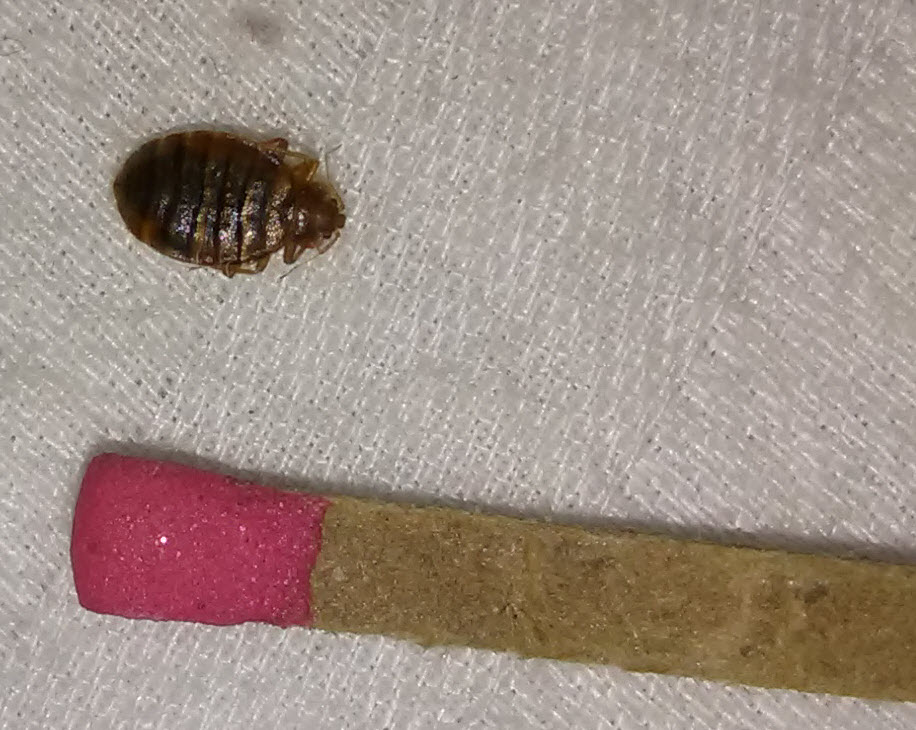
Size of an adult bedbug - Image by bedbugs.org
Anyone can perform a visual inspection; however, it's not the most reliable detection method for several reasons. For one, bedbugs are active at night and nest almost anywhere in a home, making it difficult to find the bugs just by looking for them. However, not everyone has professional pest management equipment to detect or to monitor bedbug activity. If you're performing a visual inspection, you will need at least two tools to help with your search:
- A flashlight
- A magnifying glass
A flashlight will come in handy to help you spot the bugs and their visual signs in the dark areas of small crevices and voids. A magnifying glass will help you to spot the eggs and the nymphs, including any feces on and around the infestation site. It may help to use the magnifying glass throughout the inspection given the bedbugs' size and the tiny spaces in which they infest.
You can either start with the edges of the room and move inward or vice versa, starting with the bed and inspecting outward until you've checked under, behind, inside and around every object in the room. Bedbugs will oftentimes move farther into furniture, making it hard to spot them even with a flashlight. If you're in doubt and suspect an infestation in areas where you can't inspect, consider hiring a pest management professional to assist you.
Monitor the Activity
Before you begin treatment, it's smart to monitor the activity. Using insect monitors will help you to detect infestation levels and give you a better idea of which treatment method to perform. Some people use heat to kill the bugs; other use isopropyl alcohol. Pest management professionals may suggest a combination of heat and insecticidal treatments to provide a one-two punch. No matter whether you use a heat treatment or spray the interior with nonrepellent insecticides, you will have to monitor the bedbugs afterward and to retreat the area depending on the severity.
Bedbug Treatment: Eliminating the Pests

A bedbug infestation - Image by bedbugs.org
You don't always need to hire pest control professionals to eliminate bedbugs. You can treat the infestation by yourself with the right tactics and supplies. However, it's not as simple as fogging a room and returning to a bedbug-free home. You'll have to know the severity of the infestation beforehand and have a good understanding of the various treatment methods and how to use them effectively.
You first need to pretreat the area before applying any pesticide or heat treatments. It's tempting to start right away with sprays and fogs, but the bugs will only come back if you don't take the steps to ensure total elimination.
Pretreating the Room
- Move the bed away from the wall to give yourself the freedom to check for and to treat bedbugs without obstacles in the way.
- Remove the sheets and the pillowcases from the bed, and put them directly in a plastic bag in the same room.
- Place bedbug interceptors under every leg to capture the bugs as they try to escape off the bed.
- Remove any storage items from under the bed, and keep them in the same room to prevent spreading the infestation to other areas.
Gather all of the clothing in the room, and place it in plastic containers or garbage bags. You will then move these items to the laundry room and place them directly in the dryer. You can also use a blow dryer to heat-treat the items and to kill bedbugs on the spot.
Note: Bedbugs die when they're exposed to temperatures above 113 degrees Fahrenheit.
How to Kill Bedbugs
Heat treatments: You can get rid of bedbugs in a couple of ways: heat treatments and chemical pesticides. Heat treatments are typically administered by a professional with equipment to kill the bugs throughout the space. Cold treatment is also effective but used mainly to kill bugs on surfaces such as clothing. Infected items are placed in a freezer and left for four days in 0 degree temperatures. Heat treatments bake the bedbugs in and on infested items such as sheets and clothes.
Chemical Treatments: You can't use just any over-the-counter insecticide to kill bedbugs. The insecticide must contain specific ingredients, and the insects must be listed on the label. Otherwise, you'll be using an ineffective product and risking a heavier infestation. Insecticides come in many different types such as:
- Liquid
- Granular
- Dust
- Aerosol
- Fog
When fighting bedbugs, a fogger works well to blanket the infested area. However, you should not use a fogger alone. The fog might not penetrate every crack and crevice, leaving the bugs to infest the space. A combination of liquid sprays, fogs and dusts will provide more effective results and eliminate the infestation quickly.
Which Bedbug Insecticides Should You Use?

A variety of bedbug products available at Pedchem
Pedchem has a variety of insecticides that specifically target bedbugs in homes, businesses, institutions and other buildings. In fact, we have an entire bedbug section with additional information about these pests as well as recommended products for use. Whether it's aerosol sprays or insecticide dusts, these products kill the bedbugs quickly and provide residual bedbug control in some cases. Some of our most recommended products include:
- Bedlam Plus Aerosol: This aerosol contains a synthetic pyrethroid that quickly knocks down bedbugs. It also contains a synergist and will keep working for up to two weeks after spraying the aerosol in the target area.
- Alpine Dust: This insecticide contains two ingredients for maximum pest control. Dinotefuran targets the central nervous system while diatomaceous earth cuts through the exoskeleton and causes dehydration and death.
- CB-80 Aerosol: With pyrethrin as the active ingredient, this aerosol spray goes to work on contact and kills the pests. It also contains an enhancing agent for faster death.
- Crossfire Bedbug Concentrate: This liquid insecticide must be mixed with water and sprayed on the target area. It contains three ingredients for killing adult bedbugs as well as the larvae and the eggs.
- PT Alpine Flea and Bedbug Aerosol with IGR: This aerosol spray not only contains a fast-acting pyrethroid for quick kills but also an insect growth regulator. It knocks down adult bedbugs and stops the young from maturing into breeding adults. It affects bedbugs at all life stages, providing complete control even with heavy infestations.
How to Use Bedbug Insecticides
Liquid concentrates should be mixed with water and applied to the target area with a hand or pump sprayer. Apply the solution to floors, bed frames, walls and other places where bedbugs hide and breed. Follow the instructions for safety when spraying liquid insecticides indoors where people eat and sleep. Some concentrates can be used in fogging equipment, but refer to the label for exact directions.
Insecticide dusts can be applied directly from the bottle, especially if they have duster tips. You can also use a duster and apply the insecticide in areas where bedbugs infest and may find ways indoors. Dusts are ideal for residual control as they continue to work for weeks or months after an application if they're left undisturbed. You can also use them for preventative bedbug control in high-risk areas.
Aerosol sprays are ideal for killing bedbugs on sight. They come with convenient applicator straws for precise pest control. These insecticides provide quick knockdown and can be used in cracks and crevices and on surfaces where bedbugs are found. Many aerosol insecticides are designed to prevent staining and can even provide residual activity for up to two weeks.
Prevention is the Key to Bedbug Control
Once you've treated an area, it's important to use preventative techniques if you want to keep bedbugs out of your home in the future. Sometimes one treatment isn't enough if you have a massive infestation. If you've failed to destroy the eggs, they will hatch and unleash another infestation within weeks. Multiple treatments are oftentimes needed to eliminate the bedbugs. When they're gone, it's up to you to prevent them from coming back and wreaking havoc in your home.
Preventing Bedbugs: The Final Step
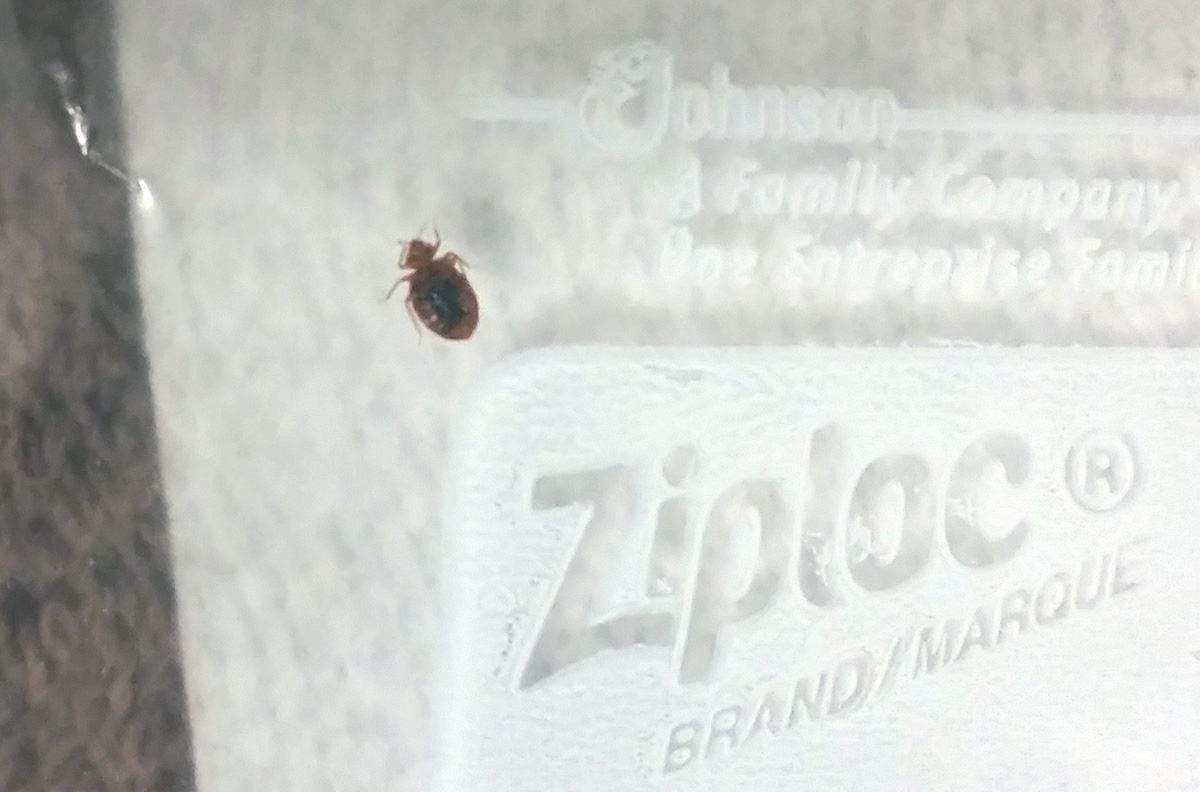
A bedbug trapped in a plastic bag - Image by bedbugs.org
Prevention only helps if you know how the bedbugs got into your home in the first place. If you identify the cause, you can make the changes and be able to prevent another infestation down the road. Because bedbugs hitchhike from place to place, you'll need to perform more inspections when you bring used items into your home or spend time in a hotel. It even pays to check the bedding if you're sleeping over at a friend's or family member's house; you can never be too careful.
How to Prevent Bedbugs
Though bedbugs usually feed once every week to 10 days, they can live for months without a blood meal. This ability to live for so long without food makes them very resilient and able to hide out and to wait for the right opportunity to strike.
You may have bedbugs in your home and not even know it. They can hide most anywhere due to their small size and feed on you and your family during the night; they will also feed during the day if they're disturbed in their nesting place. Taking a few precautionary measures will help to keep these blood-sucking pests out of your home.
7 Ways to Prevent Bedbugs at Home
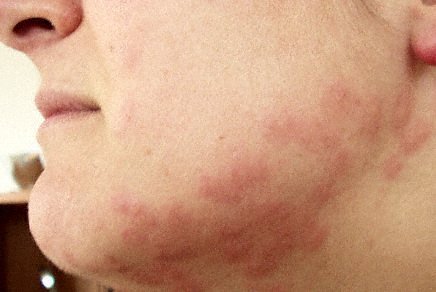
A bedbug rash on a person's face - Image by bedbugs.org
Check used furniture.
Yard sales sometimes have nice furniture for purchase at a great price. It's very tempting to buy a couch outright and to load it up on your truck for the ride home. However, you and the sellers may not know that the furniture is infested with bedbugs. Before you buy secondhand furniture, look for the signs of bedbugs, such as little black dots, blood smears and any live insects. Check in the seams, under the cushions and any other place where bedbugs could be nesting out of sight.
Reduce clutter in every room.
Bedbugs will nest in and around almost anything in your room. If your living areas or bedrooms are filled with clutter, you're giving these insects excellent places in which to nest and to increase their population. Take inventory of your room, and separate items into sections of what you plan to keep and what you want to get rid of. Clean up a messy room, and don't leave clothes piled on the floor. Put away anything that gets in the way or takes up floor space.
Use protective mattress covers.
A mattress encasement goes a long way in keeping bedbugs out of your bedding. It wraps the mattress in a protective covering and prevents the insects from gathering in the seams and folds and nesting during the day. Mattress encasements are also hypoallergenic and waterproof, so they're great for people with sensitive skin. They also protect your mattress from stains if you spill a drink on the bed. They're multipurpose coverings and ideal for use in homes, hotels, bed and breakfasts and other lodgings.
Be mindful at laundry facilities.
If you have to wash your clothes at a laundromat, take extra precaution. Bring your clothes to the facility in a plastic bag, and place them directly in the washer. Afterward, transfer the washed items to the dryer. Drying your clothes on high heat will kill any remaining bedbugs that survived after the wash. Though you could fold your clothes on the provided tables, it's best to remove them from the dryer and to take them home. If you have an infestation, use a different bag for the ride back.
Vacuum the carpet regularly.
Bedbugs don't only nest in beds; they also nest in carpets, especially along baseboards and furniture. Take the time to vacuum every day if you know there's an active infestation in your home. Move the furniture around, making sure to vacuum underneath where the bugs congregate. Use various vacuum attachments that make it easier to capture bedbugs in hard-to-reach places and tight crevices.
Invest in a heating chamber.
A portable heating chamber comes in handy to treat your clothes for bedbugs. You can take it with you on vacation to a rental home or while on a business trip to a hotel. It heats up beyond 120 degrees Fahrenheit and kills bedbugs instantly. A heating chamber is lightweight yet big enough to treat bulky clothes and bed sheets. If bedbugs have infested your home, a heating chamber will act as one part of a successful elimination and prevention program.
Secure your house or apartment.
Bedbugs don't always get into homes by hitchhiking. They enter through cracks and crevices like any other insects do. Therefore, it's important to inspect your home for possible pest entryways and to seal them up before you encounter an infestation. Use silicone or foam sealants to fill up the gaps around vents, pipes and wiring that could give bedbugs easy access into your home from the outside. Install door sweeps to prevent bedbugs from moving to different rooms.
Preventative Insecticide Control
Though we discussed insecticide treatments earlier, you can also use them for prevention. Dusts work well for preventative pest control. The ingredients attack the exoskeleton and continue to work for months in undisturbed areas. Drione insecticide dust provides residual control for up to six months and can be used in commercial interiors to kill and to prevent infestations. Alpine dust also provides similar residual control but can be used in homes and businesses. Using a dust will not only help to rid your home of existing bedbugs but also provide backup against future infestations.
Keep Bedbugs Out of Your Home for Good
With a solid understanding of bedbugs and their behavior, you're better prepared to remove an infestation and to prevent any problems in the future. If you've had bedbugs, you should always take some time every other month to inspect for more insects. A recurrence can happen when you least expect it, and you don't want to deal with another infestation later. Use preventative pest control products to your advantage, and take measures to block pest entryways around your home. Even though the bedbugs may be gone, your job to keep them out is never done.





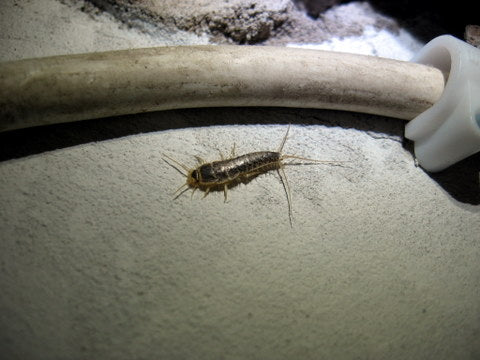
Leave a comment (all fields required)